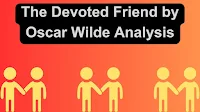The Devoted Friend Analysis
The Devoted Friend was written by Oscar Wilde. There are various elements of The Devoted Friend analysis like themes, language, and symbolism. The themes are: Learn English Language and Literature with me on Preply 1. Selfishness:Greed is the dominant theme in the story. Also, the character of Miller is the most befitting example of selfishness. The author depicts Miller ironically as the best friend or the most devoted friend of Hans. For example, when Miller blackmailed Hans emotionally to fetch a doctor for his injured son's cure on a stormy night, then Hans got drowned on the way in helping Miller's son. Miller's greedy nature caused the death of Hans. So, the self-indulgence of a dishonest friend showed negative results for his extremely faithful friend in the story. 2. Innocence:Hans' character is an example of extreme simplicity in the story. He was so innocent that he was unable to understand the hidden self-indulging motives of Miller behind his sweet talks. Miller always got benefits from Hans, but he never gave him anything in return. Further, Miller always said that he would give his faulty wheelbarrow to Hans for his gardening soon, but he never acted upon his saying. Also, Miller was a friend of only good times. As an instance, he always took the items from Hans' garden during the summer, but he never visited Hans during the winter when Hans was facing difficulties due to having no gardening (source of income). In this way, the character of Hans represents emotional foolishness in case of friendship. Symbolism is another literary component in The Devoted Friend, and the symbols of the short story are: 1. Rat:The rat is a symbol of lower-class people concerning moral values for his disgusting views about friendship. He thinks that a true friend must be a devoted one, and he expects everything from the other person without giving him/her anything in return. Also, the mentality of the rat gets proven by his favouring that Hans' fake friend (Miller) from the story told by some bird. 2. Duck:The duck is a symbol of middle-class people regarding morality because she teaches her children about living their lives in the pond with high heads. It means that she wants her kids to move on in life by having some priority for self-respect which is the result of being ethical. 3. Linnet:The bird or linnet is a sign of upper-class people for ethics. It is the linnet who tells a moralistic story to that insincere rat about the real friendship of Hans. However, the rat gets annoyed after knowing that the story is moralistic. Then, there are some impressive quotations in The Devoted Friend. Some critically important last lines of the story are: 'I am rather afraid that I have annoyed him,' answered the Linnet. 'The fact is, that I told him a story with a moral.' 'Ah! that is always a very dangerous thing to do,' said the Duck. And I quite agree with her. These lines play an important role in determining the nature of the story. After the analysis of these lines, it appears that the rat displays the real face of society. In general, people don’t like moral stories because they think that such stories reflect something which they want to avoid. They don’t want to correct themselves morally, so they get annoyed on listening these stories like the rat did after listening the linnet’s story of Hans and Miller. Also, in the end, the writer says that he agrees with what the duck said about society’s fun-based attitude towards stories. So, it means that he knows somewhere that he has also annoyed the people through his tale, who wanted to read his story just for entertainment. There are other literary devices of The Devoted Friend as well. Some of them are: Language:The language of the short story is figurative. Figurative language is that which uses figures of speech to express something effectively, persuasively, and impactfully. Also, the figures of speech are simile, imagery, irony, and symbolism etcetera. For example, in The Devoted Friend, the writer mentions the resemblance between the rat's tail and a long bit of black Indian rubber. As an instance of the sound imagery, the writer shows that the rat says 'pooh' (an expression of disapproval) upon knowing that the linnet's story is moralistic. Further, the story is also ironical because Miller was not a devoted friend in reality despite being called the most loyal friend of Hans in the story. So, in many ways, the language of the story is a figurative one. Style:Its style is conversational because there is a continuous expression of dialogues by the characters and once by the writer himself. For example, the duck says that it is always a dangerous thing to tell a moralistic story. Then, the writer says that he agrees with her completely. So, the whole story is in the form of dialogues. Genre:According to its genre, it is an imaginative and tragic tale. It is tragic due to the death of an honest man called Hans. Further, it is unreal for animals' human-like communication. Tone:Its tone is serious for having a tragic story told by linnet about the death of a loyal friend named Hans. Also, the tone is grave for the unfriendly interaction between the cruel rat and two good-natured animals, duck and linnet. Conclusion:That's all about The Devoted Friend analysis. Thanks for being here. Subscribe my blog for more updates. Relevant Page: |
